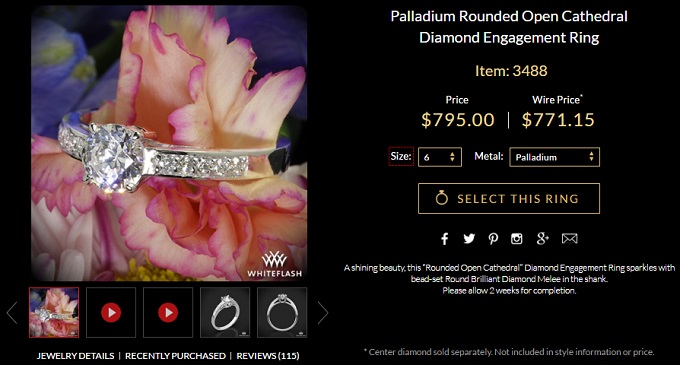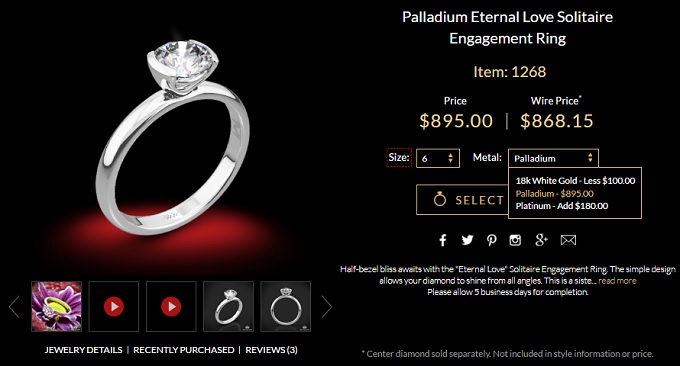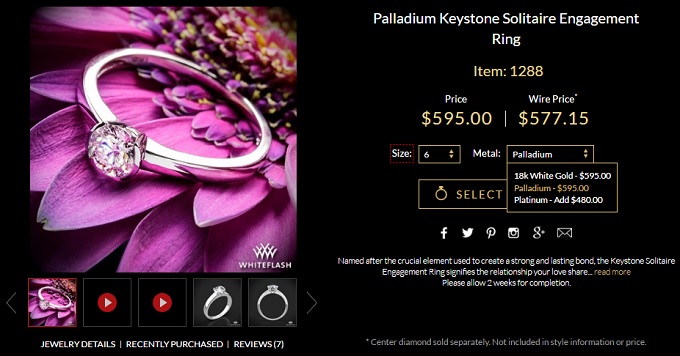Palladium Review – Comparison Against Other Popular Metals
You probably found this page while searching for information on “palladium vs platinum” or “palladium vs white gold rings”. Well, you aren’t alone and the good news is you are at the right place.
In this article, I’m going to address the differences between palladium and some of the commonly used jewelry metals like platinum and 18k white gold.
First of All, What is Palladium?
Palladium is a naturally white metal belonging to the platinum group metals (PGMs) consisting of six transitional metal elements – platinum, palladium, iridium, ruthenium, rhodium, and osmium.
Aside from platinum, palladium is the only member of the group that is used as a primary component in jewelry. It has working properties similar to platinum and is capable of a high-luster finish for jewelry pieces.
Click here to browse through palladium engagement rings from White Flash.
Palladium vs Platinum Rings
Pros: Palladium is slightly harder than platinum on the Mohs scale and is slightly more scratch resistant than platinum. Compared to platinum, palladium jewelry is generally less expensive (about 0.6-0.8 times) and more in line with the cost of gold jewelry.
There are two reasons for the significant difference in pricing between platinum and palladium in jewelry. One is the spot price of the metals – at the time of writing this article, platinum is over $1000 per ounce and palladium under $800. Both are typically used in 90-95% pure form in jewelry.
The other is the density of the metals themselves. Platinum is very dense per volume compared to palladium. The weight of a finished piece in platinum is much greater (and therefore more costly) than the same piece made in palladium. The compounding effect of spot price with gram weight makes palladium far less costly in jewelry.
Cons: If the weight of the finished jewelry piece matters to you, you may prefer the heavier and more substantial feel of platinum.
For this particular design, there’s only a $180.00 difference in cost for a Pt vs Pd setting.
Palladium vs White Gold Rings
Pros: As I mentioned earlier in the article, palladium is naturally white and doesn’t require plating or re-plating during the course of its lifetime. In contrast, white gold rings may require a rhodium replating once every few years to maintain its white shiny appearance.
Secondly, palladium is hypoallergenic. This removes the risk of skin sensitivity to gold alloys which typically contain nickel. On this note, only a minority of people are allergic to white gold. Even if you happen to be one of them, I would actually recommend platinum as a better alternative over palladium.
Cons: White gold rings are typically harder and more scratch resistant than palladium rings because of their alloy composition. For the same reason mentioned previously: if you are someone who wants to feel a slight weight on your fingers when wearing a ring, 18k white gold will be a better choice over platinum because of its density.
For this particular design, there’s no price difference for a Pd vs a 18k WG setting.
Why Isn’t Palladium Popular for Engagement Rings?
While palladium possesses some favorable properties, you may be surprised to know that it isn’t a very popular choice in bridal jewelry. There are a couple of reasons for this.
Firstly, the light weight of palladium, while helping to keep the price affordable, is not appealing to some buyers. For those accustomed to the “heft” of fine jewelry made in platinum and 18K gold, palladium does not provide the same feel when worn.
Secondly, not all jewelers are experienced in working with palladium. It has slightly different properties for casting and soldering which requires specific knowledge/equipment of working with the metal.
As a result, there are only a few jewelers who have experience with palladium as most would avoid it due to the low demand from consumers. So, if you are the owner of a palladium ring, it may be inconvenient to get servicing or repairs done.
Should You Choose Platinum Or Palladium Or White Gold?
Palladium became an attractive alternative at a point in the past where the price of platinum spiked. But with the prices of the two metals considerably closer together today, the benefits of a palladium ring are waning.
Palladium is somewhat of a middle ground for being less expensive than platinum and being more expensive than gold.
At the end of the day, the choice of metal depends on personal preference. Each of these 3 metals have their distinctive advantages and disadvantages. In my personal opinion, I take on a practical approach towards buying jewelry and would stick with 14k/18k white gold (mainly for costs reasons).
What about you?
Given a choice, which type of metal would you choose for your engagement ring and why? I would love to hear what you think. Do leave a comment below to let me know!
Leave A Comment













4 Comments
I am in the process of buying an engagement ring and my girlfriend has expressed that she would like a 5-stone ring, so 2 diamonds on each side of the main diamond. I was previously looking at palladium rings and after I found out what palladium is used for in jewelry as well as their pros and cons, I decided against the idea.
I have several questions regarding the quality of the side diamonds. To start, this is the center diamond I am looking at getting. https://www.jamesallen.com/loose-diamonds/round-cut/1.55-carat-f-color-vs2-clarity-excellent-cut-sku-5331144 Before we get into the side diamond questions, can you give me your opinion on this diamond? It falls within your recommendations for cut and color, and it doesn’t have any glaringly obvious inclusions, but it also only gets 1 for proportion factors in the AGS report. I haven’t yet, but I plan on requesting an idealscope image of this diamond from James Allen.
Ok, now onto the side diamonds. I obviously want quality side diamonds, but I’ve read you don’t want them to be better than the main diamond. My total budget is $20k, so with the above center diamond and assuming around $1k for a setting, I could spend up to $4k on side diamonds. Now here are my questions.
Cut – Is it important that the side diamonds still fall within the cut guidelines you have on your website, or can those be relaxed a little? If they were still graded as ideal cut, but maybe slightly off your recommendations is that ok? Would a vendor like James Allen even let me dictate the side diamond cut, or are they just going to give me 4 diamonds to go with the setting? I haven’t really seen any standard 5-stone settings, so I plan on having it custom made through James Allen.
Carat – This one is the biggest unknown. I read that for 3-stone rings they recommend that the side stones are 1/3 – 1/2 the size of the main diamond, but for a 5-stone ring I don’t know if 4 stones half the size of a 1.5 carat center diamond would even fit comfortably on a ring. My girlfriend has mentioned that she things anything below 0.3 carats would be too small to have noticeable sparkle, but then I worry that 4 side diamonds that are too big would overpower the center diamond, because she has also mentioned that she wants the center diamond to be prominent. Can you make any recommendations as to the size/proportions of the side diamonds?
Color – Since the center diamond is F, I’m assuming I wouldn’t want anything better than F, but how much lower could I go before the side diamonds are noticeably more yellow than the center? I think G would be ok, but what about H or lower?
Clarity – I think the goal with clarity is the same with the main diamond, that you don’t want any really obvious inclusions right on the top of the diamond. So, should I stick with VS2 or better to keep the eye-clean look, or since the side diamonds are smaller, would SI1 or SI2 be ok?
Sorry for the long email and thanks for all the help
https://www.jamesallen.com/loose-diamonds/round-cut/1.55-carat-f-color-vs2-clarity-excellent-cut-sku-5331144 is a well cut diamond. The proportions factor is a very minor thing as it should relate to one of these: Weight Ratio, Durability, Girdle, Tilt, and Culet. I don’t have the diamond on hand and can’t tell you which of it is causing it to be rated as 1. Ask the JA gemologist about this.
In any case, it isn’t a problem and I have no issues buying this diamond for myself.
Read: https://beyond4cs.com/jewelry-guide/what-are-accent-diamonds/
JA will not allow you to dictate the side diamonds unless it is a custom setting. I would say that James Allen uses very good accent diamonds. If you expect the top of the line accent stones, then you need to go to White Flash or Brian Gavin. And yes, cut quality on the sidestones are important. It does affect sparkle.
https://beyond4cs.com/engagement-ring/three-stone-diamond-ring-setting-and-meaning/
For carat size of accent stones, it is up to individual preferences. You may want to look at some of the previously purchased rings and find a 1.5 ct ring and LOOK at the sidestones of that ring in relation to the center stone. This should give you an idea of proportioning.
The color/clarity issues are addressed in the link above. It is perfectly ok to go a few grades away from the center stone and NOT see any differences.
I’m considering the choice of palladium vs white gold for an anniversary ring. Is palladium better than white gold if I want it to be long lasting and durable.
Palladium is somewhat malleable and when knocked against a hard surface, it doesn’t lose metal but displaces it on the micro level. Polishing palladium is a lot more labor intensive compared to white gold or platinum. This is also one of the reasons why you don’t see many designs available in this particular metal. As to which is better or worse, it really depends on what you value more. Are you allergic to nickel? Are you OK with the significantly higher costs?